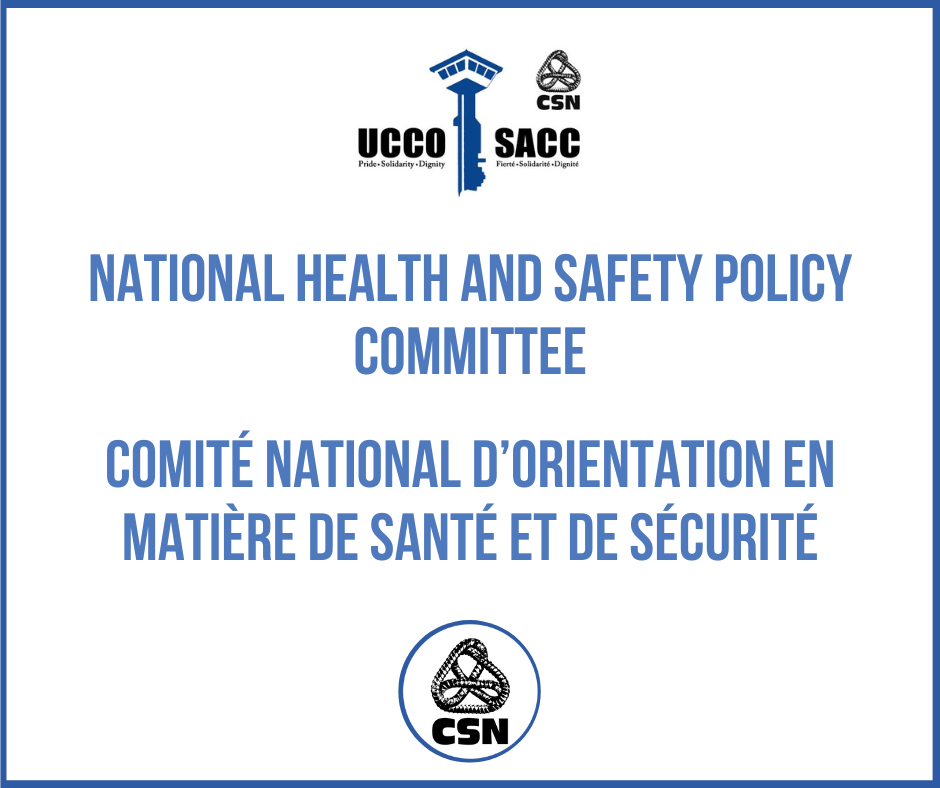The National Occupational Health and Safety Policy Committee convened on June 19. This steering committee meets four times a year to discuss health and safety issues affecting all Correctional Service staff. All the unions are represented on the Committee, with UCCO-SACC-CSN holding two seats. In attendance at the previous meeting, held via videoconference, were Frédérick Lebeau, National Vice-President, and Martin McAllister, OHS Coordinator for Ontario (replacing James Bloomfield, Regional President for the Prairies). In addition, Québec OHS Coordinator Frédérick Desjardins was on hand to discuss the issue of flashing lights on escort vehicles. Here are some of the key issues on the agenda.
Needle Exchange Program and Overdose Prevention Sites
The employer is stubbornly going ahead with the harmful Needle Exchange Program. At a meeting with both the operations and health sectors, the employer announced a forthcoming consultation regarding the future CD 585 on the National Drug Strategy. It seems that CSC is moving toward a new, even more dangerous model for the National Drug Strategy. Our managers are creating a perfect storm. The health sector would like to set up several other needle exchange programs and at least one overdose prevention site in most of our institutions. Some of our institutions will even have both programs. Some regional and local managers had access to a list of targeted establishments, but there was no consultation with the union. What a futile and deplorable lack of transparency! Unfortunately, “our future neighbours” will undoubtedly be more dependent on drugs than upon their arrival. NHQ and the government are barking up the wrong tree.
Respiratory Protection Program
In the past month, an industrial hygienist toured two institutions in the Ontario region, accompanied by Correctional Service representatives and Ontario OHS Coordinator Martin McAllister. These tours are part of an effort to assess and overhaul the respiratory protection system. The industrial hygienist will produce a report within the next few weeks, which should be available for consultation at the next National Committee meeting. In addition, the National Research Council of Canada has carried out fire simulations in cells with several types of materials and different kinds of supplies. These tests should also be available at the next Committee meeting. We are following this matter very closely.
The National Comprehensive Strategy on Workplace Wellness and Employee Well-being
The Correctional Service continues to work on workplace wellness and employee well-being. The group that performed the assessment gave us a presentation. Many theoretical concepts were developed as part of its research. We asked what this national strategy would change in the day-to-day lives of Correctional Officers. Would such a strategy reduce our fear of increasing violence in our institutions? Without adequate protective equipment, will we be able to avoid accidental pricks with contaminated needles? Will there be greater inmate accountability, thereby facilitating our role and giving us real power to make changes? Wellness at work and employee well-being may be achieved by various means rather than by abstract or academic theories. There are still many tangible things the employer can do to earn a passing grade with regard to occupational well-being. On hot days or heat wave, for instance, the employer can hand out bottles of cold water or Gatorade. This is a simple and inexpensive gesture that we’ve already mentioned. Unfortunately, it would seem that this suggestion was quickly forgotten after the discussion.
Lightbar on Escort Vehicles
A number of special guests were present to follow an AVC from Employment and Social Development Canada that the consultation had not been carried out properly and to respond to the many complaints (127) on the subject from Québec. This issue has been ongoing since last September in the Québec region and since 2012 in the rest of the country. We asked the employer for the minutes of the 2012 meeting that led to this decision for the country as well as the risk assessment that was carried out and all the consultation work conducted at the time to provide a full understanding of the decision, which affects the working conditions of all Correctional Officers in the country. All these questions and requests have remained unanswered. The Québec region’s work, with support from national representatives in recent months, was botched by the managers in charge of the matter at the time. It will be revised and revamped in tandem with the new operations team. We need to start this consultation process again so that we can jointly plan for the removal or retention of flashing lights on escort vehicles, depending on the findings of the assessment. The risks involved in this issue are very real; in fact, during the evacuation of Port-Cartier, these risks took concrete form. An unfortunate accident might have occurred had it not been for the extra vigilance of the Correctional Officers assigned to the transfer. Unfortunately, this issue seems to be yet another example of prioritizing savings over safety.
Implementation of the CSC National Clean-up Strategy
We have some good news! The Correctional Service has been able to secure budgets to provide many parts of our workplaces with professional cleaning services. Many areas that are not accessible to inmates will now be cleaned by specialized firms, so that we can work in clean, germ-free environments.
Work-boot Allocation for Correctional Officers
We are working with the employer to boost our work-boot allocation. A task force that included Frédérick Lebeau, National Vice-President, and James Bloomfield, Regional President for the Prairies, conducted an assessment showing that the allocation received this year was no longer adequate given the rate of inflation in recent years. The last evaluation was carried out in 2014. The task force recommended an amount of $400 every other year. This recommendation will be submitted to the Finance Department in the next few weeks and is on track for implementation in two years’ time. We raised the question of whether it would be possible to obtain bridge financing for fiscal 2025-2026, and are still awaiting confirmation from the employer.
In closing
You are, of course, all well aware of the importance of the National Occupational Health and Safety Policy Committee for real and effective consultation, as set out in the Canada Labour Code, Part II. While our representatives have formally notified the employer in recent months of their growing concerns regarding the employer’s willingness to work with employees in a constructive and consensual manner, little real change appears to have taken place since March 2024. Many issues that the Committee has handled have or will have a significant impact on our working conditions and occupational health and safety. Unfortunately, the employer is increasingly managing the Committee as a performance indicator and is not making any real effort to meet its legal obligations. It is always very worrying to see our employer purport to recognize the rule of law in their mission and values while, in fact, flouting it and taking its obligations lightly. Employment and Social Development Canada is the body responsible for applying Part II of the Canada Labour Code, and we will be asking for its help shortly if no drastic changes are made to our members’ occupational health and safety. No Correctional Officer must ever suffer an accident at work due to laxity and poor management of the Committee.

